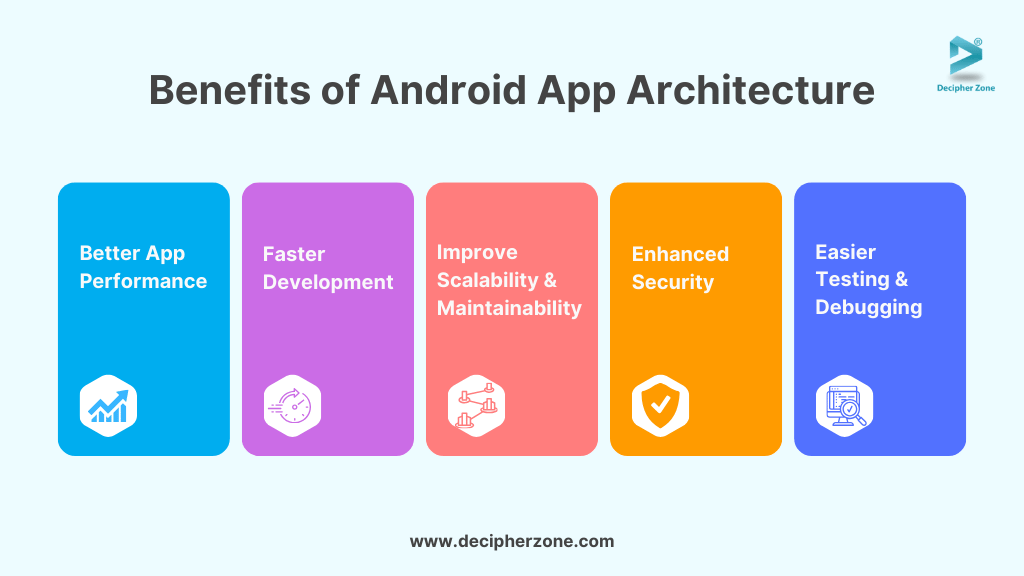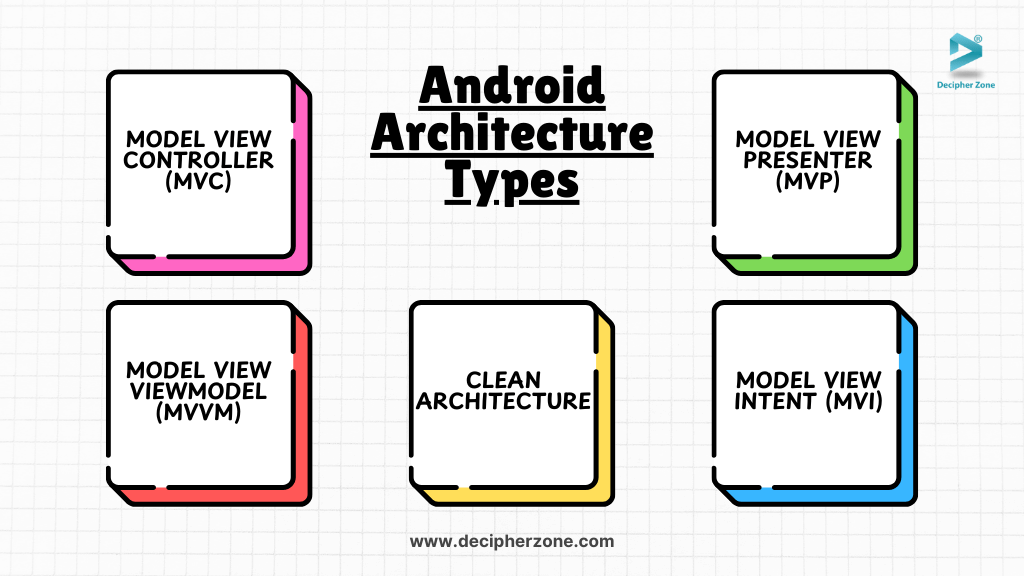Quick Summary: In this blog, we will delve into the crucial role of architectural patterns in developing Android apps, which are indispensable for handling complexity and scalability in applications. It underscores the significance of choosing the right architecture to ensure resilient and maintainable code, ultimately improving app performance and developer productivity.
Have you ever wondered why some Android applications handle complexity and scalability so well while others struggle? The answer lies in the Android architectural pattern chosen by the customer or developer. These patterns are crucial in app development as they define the code structure and how various components interact. With numerous options available, the challenge is to select the best design for your specific project.
This article will delve into the complexities, benefits, and drawbacks of prominent architectural patterns, making it a valuable read for newcomers and experienced developers looking to enhance their expertise.
Moreover, familiarizing yourself with these patterns could be advantageous if you're considering developing an Android app for your business or collaborating with an Android development company. It will enable you to make well-informed decisions regarding the project's architecture.
Read: Top 10 Best IDEs For Mobile App Development
What is Android App Architecture?
Android app architecture encompasses the organization and design of the app, outlining how its various components interact and how data moves within the app. A carefully planned architecture ensures the app's scalability and robustness, facilitating easier testing of its functionalities.
When creating an Android app, it's crucial to adhere to specific architectural principles to guarantee that it is well-organized, easy to maintain, and operates efficiently. Some commonly employed principles are:

-
Separation of Concerns: The principle emphasizes the importance of dividing a computer program into individual sections, with each one focusing on handling a specific concern.
-
Driving UI from Data Models: This approach implicates constructing the user interface of the app based on the underlying data models, ensuring that the UI accurately reflects the data through data binding or view building.
-
Single Source of Truth: It advocates for maintaining a single, centralized source of truth for the app's data, which helps avoid inconsistencies and makes data management more straightforward.
-
Unidirectional Data Flow: This principle involves managing data flow in a single direction, which simplifies debugging and understanding of the app's behavior.
Why Does Android App Architecture Matter?
With a glimpse of the Android app architecture and its principles, it is time to understand why it matters. To help you comprehend its importance, we have listed the advantages that it offers:

-
Better App Performance: Implementing the right Android app architecture ensures that the code is well-organized and performs as expected. It also guarantees smooth transitions, faster interface load time, and improved user experience while avoiding crashes, slow load time, or memory leaks.
-
Faster Development: With the right Android app architecture, developers can reduce code complexity, making it bug-free, clear, and easy to understand resulting in accelerated development. A structured architectural pattern makes writing code simpler, collaborating easier, and debugging efficient.
-
Improved Scalability & Maintainability: With time, it becomes essential for the app to evolve and expand to meet the market requirements. Integrating the right app development architectural pattern makes the code scalable and easier to maintain, allowing developers to fix errors, add new features, and make other changes without affecting the performance of the application.
-
Enhanced Security: Implementing a well-designed app architecture strengthens security by incorporating authorization, authentication, data handling, and encryption. This approach minimizes security breaches and improves user data protection.
-
Uncomplicated Testing & Debugging: Keeping your code organized into different layers using Android architecture patterns simplifies the testing and debugging process of your application. It enables you to test each layer independently, catch issues earlier in the development stage, and focus troubleshooting efforts to resolve problems more efficiently.
Read: Guide to Native Mobile App Development
Types of Android App Architecture to Choose From
As the requirements and needs of an application vary based on the business, developers need to choose the ideal one from different types of Android App Architectures available in the market. Some of the most commonly used architectural patterns are listed below:
-
Model View Controller (MVC):
Model-View-Controller (MVC) divides an Android application into three distinct components, each with its responsibilities. The Model component is responsible for handling data storage and manipulation, as well as implementing the business logic of the application. The View component is in charge of managing the user interface and handling user interactions, while the Controller acts as an intermediary, responsible for communication between the Model and the View. This clear separation of concerns makes it easier to develop, test, and maintain Android applications.

-
Model View ViewModel (MVVM):
The MVVM (Model-View-ViewModel) architecture pattern is designed to support the segregation of user interface development and back-end logic. In this pattern, the view is isolated from any specific model platform. The viewmodel in MVVM acts as a mediator, handling the task of exposing and transforming the data objects from the model. This transformation makes it easier to manage and display the data in the user interface, providing a flexible and efficient way to present information to the user.
-
Model View Presenter (MVP):
In the software architecture pattern called Model-View-Presenter (MVP), the model represents the data and business logic, the view represents the UI components, and the presenter acts as an intermediary that retrieves data from the model, processes user inputs, and updates the view accordingly. This pattern is similar to the Model-View-Controller (MVC) pattern, but in MVP, the presenter plays a more active role in managing user interactions and updating the view.
-
Model View Intent (MVI):
The MVI (Model-View-Intent) architecture is centered around the reactive programming paradigm, which focuses on unidirectional data flow and immutable state. This design approach aims to simplify the understanding and forecasting of application behavior by ensuring that data flows in a single direction and state remains unchanged once set. In the MVI architecture, intents are represented as immutable data objects, and they play a crucial role in capturing and conveying user actions within the application.
-
Clean Architecture:
In this architecture, the application is divided into three main layers: the presentation layer, the domain layer (also known as the use case layer), and the data layer. The presentation layer is responsible for how the data is presented to the user, ensuring a user-friendly and visually appealing interface. The domain or use case layer contains the core functionality of the application, defining the business logic and rules that govern the behavior of the app. Finally, the data layer dictates how the application's data is accessed and manipulated, including interactions with databases, web services, and other data sources. This separation of concerns allows for better organization, maintainability, and scalability of the application.
Why Partner with Decipher Zone as an Android App Development Company?
In today's ever-changing digital world, it's essential to select the right partner for Android app development if you want to gain a competitive edge and improve user experience. With a decade of experience, Decipher Zone excels at creating strong and scalable mobile app solutions, positioning us as an outstanding choice for businesses seeking seasoned professionals to bring their vision to life.
Read: Top 10 Android Frameworks for App Development
Some of the factors that make Decipher Zone the smart choice for your business include our expertise, experience, agile development process, end-to-end services, customized solutions, competitive pricing, collaborative approach, cutting-edge technology, proven track record, and post-launch support.
Conclusion
So that was all about Android app development architecture, we hope that the blog helped you understand all the aspects associated with it. It's important to remember that the architecture used in Android app development along with the development partner plays a crucial role in the success of the mobile application.
Whether you choose MVC, MVP, MVVM, MVI, or Clean Architecture, it's essential to understand the pros and cons of each. This understanding will help you make an informed decision when selecting the right architecture for your app. By adhering to best practices and leveraging the most suitable architecture, you can ensure that your app is not only scalable and maintainable but also robust in the long run.
FAQs
-
What is app architecture in Android?
Android app architecture encompasses the organization and design of the app, outlining how its various components interact and how data moves within the app. A carefully planned architecture ensures the app's scalability and robustness, facilitating easier testing of its functionalities.
-
What are the layers of Android architecture?
The Android architecture consists of several layers working together to provide a complete system. These layers include the Linux Kernel, application framework, libraries, Android runtime, and system applications. Their combined functionality forms the backbone of the Android operating system, allowing it to run applications and provide various features to users.
-
What is the most commonly used Android architecture?
Android development offers several commonly used architectural patterns to choose from, including MVC (Model-View-Controller), MVP (Model-View-Presenter), MVVM (Model-View-ViewModel), MVI (Model View Intent) and Clean Architecture. Each of these patterns has its unique characteristics and is used to structure and organize Android applications in different ways.

